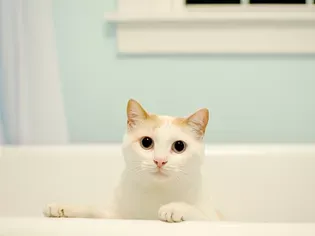What to Do if Your Cat Is Peeing in the Bathtub
Updated on 04/26/24

What to Do if Your Cat Is Peeing in the Bathtub: A Comprehensive Guide
Introduction
Discovering your cat has taken to relieving itself in your bathtub can be a frustrating and perplexing experience. Cats, generally known for their impeccable hygiene, may start urinating in unusual places for various reasons. This blog post aims to provide a comprehensive guide to help you understand why your cat is peeing in the bathtub and offer practical solutions to resolve this issue.
Identifying the Underlying Cause
The first step in addressing inappropriate urination is to identify the underlying cause. Cats are territorial animals and may use urination to mark their territory or communicate distress. Common reasons for peeing in the bathtub include:
* Medical Conditions: Urinary tract infections (UTIs), kidney disease, or diabetes can cause increased urination and discomfort, leading cats to seek alternative elimination spots.
* Stress or Anxiety: Changes in routine, such as a new pet or family member, can trigger stress and anxiety, causing cats to exhibit inappropriate elimination behaviors.
* Litterbox Issues: A dirty litterbox, an unsuitable litter type, or the placement of the litterbox in a high-traffic area can deter cats from using it.
* Environmental Factors: Cats may avoid the litterbox due to fear or discomfort from loud noises or other environmental stressors.
* Idiopathic Cystitis: This condition, also known as feline lower urinary tract disease (FLUTD), causes inflammation of the bladder and can lead to frequent urination and inappropriate elimination.
Addressing the Underlying Cause
Once the underlying cause has been identified, taking steps to address it is crucial. If a medical condition is suspected, seek veterinary attention immediately. For stress-related issues, consider providing your cat with calming aids, such as pheromone diffusers or catnip toys. Ensure the litterbox is clean and placed in a quiet, private location that your cat feels comfortable using.
Creating a Positive Association with the Litterbox
Encouraging your cat to use the litterbox consistently is essential to resolving the problem. Follow these tips:
* Make the Litterbox Appealing: Use a litter type that your cat prefers and keep it fresh by scooping it daily. Consider providing a designated litterbox area with ambient lighting and calming scents.
* Train Your Cat: Place your cat in the litterbox several times a day, especially after meals and naps. Reward your cat with treats or praise for using the litterbox.
* Use Positive Reinforcement: Avoid punishing your cat for peeing in the bathtub. Instead, focus on encouraging positive behavior by praising and rewarding them for using the litterbox.
Deterrents and Cleaning
While addressing the underlying cause and creating a positive association with the litterbox are crucial, deterring your cat from peeing in the bathtub can also be helpful. Use these methods:
* Citrus Scents: Cats dislike the smell of citrus fruits, so you can spray diluted lemon or orange juice on the bathtub rim to discourage urination.
* Aluminum Foil: Cover the bathtub with aluminum foil to create an unpleasant surface for your cat to walk on.
* Clean Thoroughly: Use enzymatic cleaners to eliminate any traces of urine, as lingering odors can attract cats to the area.
Conclusion
Peeing in the bathtub can be a frustrating issue for cat owners, but it is important to approach it with patience and understanding. By identifying the underlying cause, addressing it effectively, and implementing positive reinforcement and deterrents, you can help your cat return to appropriate elimination behaviors and maintain a harmonious living environment. Remember that consistency and a positive approach are key to resolving this issue and ensuring your cat's long-term well-being.
Explore More Pets

Cat Behavior Problems
How to Stop Aggression in Kittens

Long-Haired Cat Breeds
Siberian Cat: Breed Profile, Characteristics, & Care

Cat Behavior Problems
How to Stop Kittens From Scratching and Biting

Long-Haired Cat Breeds
Turkish Angora: Cat Breed Profile, Characteristics & Care

Basic Training
How to Socialize Your Kitten

Short-Haired Cat Breeds
Cute Pictures & Facts About Calico Cats & Kittens

Litter Box Training
Training Your Kitten to Use the Litter Box

Long-Haired Cat Breeds
10 Fun Facts About White Cats